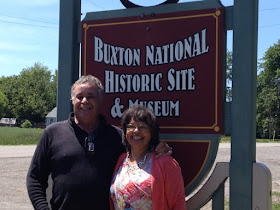A Coloured Man's Paris
 |
| A Coloured Man's Paris |
Chatham-Kent Black Historical Society invites you to visit Ontario's Black Mecca
the History of Chatham's Black Community.
"Chatham was not a Mecca only. In a broader and truer sense, it was the colored man's Paris." - Rev. Richard R. Disney, AME Church
 |
H. Blair Newby, Executive Director of Chatham-Kent Black Mecca Museum holding a bell on a slave yoke.
|
Chatham Fugitive Slave Narratives: Found in Benjamin Drew's "The Narratives of Fugitive Slaves in Canada
Narrative of Mary Younger
(A Former Slave & Chatham Resident)
"I was reared a slave, and have seen a great deal of barbarity in the State I came from. Many a time I have looked out in the moonlight, and seen my little children, just able to walk to the fields, carrying buckets of water to the hands. They used to carry the buckets on their heads: they would wear off the hair, and I used to make pads to protect the sore places where they carried the buckets.
If those slaveholders were to come here, I would treat them well, just to shame them by showing that I had humanity. A woman who lived near us, used to beat her cook, and burn her with hot irons. I have seen the burns with these eyes. The same woman whipped at different times
three of her slave women to death. The last one I was sent for by her mother to see: I found her dying. She does while I was standing by. Her mother wanted me to shroud the corpse: but the mistress interfered, and made the dead woman's mother so it. The house where these cruelties occurred, was so near outs that we could talk over the palings.
If a white man passes by a house, and a person is whipping a servant, he goes straight by-- he don't see it. I did not know when I was slave, that any white person had any sympathy for me. I thought all white people were alike, and had no sympathy for colored people. I did not know the difference until I reached a free State, when I saw the white people use the colored people like folks. I did not hear such terms applied as 'wenches', 'heifers', etc. Where I was raised, my children were often whipped till the blood ran, and then they would call me to see if I looked rumpled about it, and unless I looked pleased, I knew they would whip me.
I often wish that people from the North could just go through the southern country at harvest time, and see and hear what is done there.
There was a man whipped there one day, and at night I took pity on him and greased his back,--he died on my floor.
The barbarity of slavery I never want to see again. I have children now who have got the yoke on them. It almost kills me to think they are there, and that I can do them no good. There they are--I know how it is--it brings distress on my mind--there they are, working till late at night; off before day; and where there is no humanity--where the lash is not spared."
 |
| Welcome to Downtown Chatham-Kent |
Five Black families settled during the 1800's in "the Forks" along McGregor's Creek, which is known today as Chatham. The 1850 Fugitive Slave Law was the impetus for the Chatham Black Population to grow into the Black Mecca for both free and enslaved Blacks. During 1851, Chatham Census recorded a Black population of about 350 out of a population of 2070. Then the Black population mushroomed to 1700 out of 4500 with ten years.
 |
| Free Blacks also came to Chatham. |
After Congress passed the Fugitive Slave Act of 1850, allowing former slaves to be recaptured, after years of living in freedom. Chatham numbers increased dramatically.
 |
| First Baptist Church site of the American Abolitionist John Brown's Convention. |
John Brown chose to come to Chatham on April 30, 1858 because of the large affluent Black population. Chatham is also situated near two other Black Settlements of Buxton and Dawn. The goal of the John Brown Convention was to create a settlement for slaves in the United States similar to the Indian Reservations today.
 |
| BME Church in Chatham, site of the first John Brown Convention |
Rev. Toyer of the British Methodist Episcopal Church in Chatham refused John Brown access to the church when he learned of Brown's plans.
 |
| Harper's Ferry Virginia |
During John Brown's second meeting which was held at the First Baptist Church in Chatham, he planned the Harper's Ferry Raid. In order to create the independent slave community, John Brown and his followers planned to raid an arsenal in Harper's Ferry, Virginia to arm slaves and create a slave revolt.
On October 16, 1859, Brown and his followers attacked the arsenal but they were quickly defeated. Several men died including two of John Brown's own sons.
John Brown was captured and put to death for treason against the United States government. Osborne Perry Anderson who survived the Harper's Ferry Raid returned to Chatham and wrote a book about it.
 |
| John Brown Festival |
Every year the Chatham-Kent Black Historical Society hosts the John Brown Festival during the first weekend in May.
For More info Contact:
Chatham-Kent Black Mecca Museum
Executive Director Blair Newby
177 King St. East
Chatham, ON Canada N7M 3N1
Follow the North Star Tour was a Fam hosted by TBEX, Toronto Tourism, and Chatham-Kent Tourism.
Have you ever heard about Chatham - The Black Mecca?
Related Articles:





















